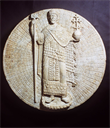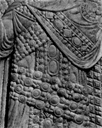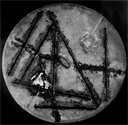Bibliography
H. Peirce and R. Tyler, "A Marble Emperor Roundel of the XIIth Century," Dumbarton Oaks Papers 2 (1941): 1-9, esp. 3ff., pl. 1, 18, 20.
The Art Quarterly (Autumn, 1941), esp. 333.
The Dumbarton Oaks Research Library and Collection of Harvard University, Handbook of the Collection (Washington, D.C., 1946), 25, no. 42, fig. p. 36.
The Dumbarton Oaks Collection, Harvard University (Washington, D.C., 1955), 19, no. 49, fig. p. 34.
C. Diehl, Byzantium: Greatness and Decline, Rutgers Byzantine series (New Brunswick, N.J., 1957), fig. p. 31.
Handbook of the Byzantine Collection (Washington, D.C., 1967), 8, no. 27.
G.-H. Zuchold, "Byzanz in Berlin: der Klosterhof im Schlosspark Glienicke," Berliner Forum 4 (1984): 1-86, esp. 24, fig. p. 27.
A. Cameron, "The Construction of Court Ritual: The Byzantine Book of Ceremonies," in Rituals of Royalty: Power and Ceremonial in Traditional Societies, eds. D. Cannadine and S.R.F. Price (Cambridge, New York, 1987), 106-36, fig. 19.
G.-H. Zuchold, Der "Klosterhof" des Prinzen Karl von Preussen im Park von Schloss Glienicke in Berlin, Bauwerke und Kunstdenkmäler von Berlin 20-21 (Berlin, 1993), no. 22.
G. Vikan, Catalogue of the Sculpture in the Dumbarton Oaks Collection from the Ptolemaic Period to the Renaissance, Dumbarton Oaks Catalogues (Washington, D.C., 1995), 104-108, no. 40, pl. 40a-c.
H. C. Evans and W. D. Wixom, The Glory of Byzantium: Art and Culture of the Middle Byzantine Era, A.D. 843-1261, exh. cat., The Metropolitan Museum of Art, March 11-July 6, 1997 (New York, 1997), 200-201, no. 137.
H. Belting, Likeness and Presence: A History of the Image before the Era of Art (Chicago, 1994), 102, fig. 52.
T. F. Mathews, Byzantium: from Antiquity to the Renaissance, Perspectives (New York, 1998) 38-38, fig. 23.
M. Hendy, Catalogue of the Byzantine Coins in the Dumbarton Oaks Collection and in the Whittemore Collection, Vol. 4, Pt. 1, Alexius I to Michael VIII, 1081-1261(Washington, D.C., 1999), 143-50.
D. Eugenidou and J. Albani, Byzantium: an Oecumenical Empire, exh. cat., Byzantine and Christian Museum, October 2001-January 2002 (Athens, 2002). (not in exhibtion)
H.-J. Kotzur, ed., The Crusades/Die Kreuzzuge: Kein Krieg ist heilig (Mainz 2004).
G. Bühl, ed., Dumbarton Oaks: The Collections (Washington, D.C., 2008), 166, pl. p. 167.
D. D. Hill, History of World Costume and Fashion (Upper Saddle River, N.J., 2011), 124, fig. 6-5.
K. L. Marsengill, Portraits and Icons: Between Reality and Spirituality in Byzantine Art, Byzantios; Studies in Byzantine History and Civilization (Turnhout, Belgium, 2013), 388, fig. 70.
B. Anderson, Cosmos and Community in Early Medieval Art (New Haven: Yale University Press, 2017), 48, fig. 19
Acquisition History
Acquired by Prince Karl Friedrich Alexander of Prussia, before 1860.
Collection of Prince Karl, Klosterhof, Schloss Glienicke, Potsdam.
Collection of Prince Friedrich Leopold of Prussia.
Purchased from H. Fiedler (dealer), Lugano, Switzerland, by Mildred and Robert Woods Bliss, October 1937.
Collection of Mildred and Robert Woods Bliss, Washington, D.C., October 1937-November 1940.
Dumbarton Oaks Research Library and Collection, Byzantine Collection, Washington, D.C.





